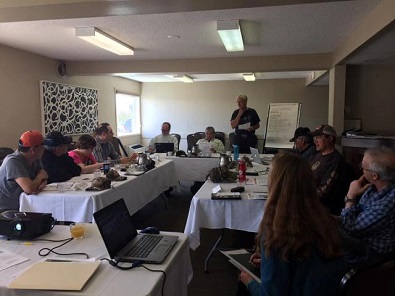BQCMB members meeting in Prince Albert. Photo courtesy Facebook.
A discussion is taking place today in Prince Albert about the importance of proper reporting of harvesting of Canada’s barren-ground caribou.
That is the focus of a group that helps oversee one of the larger herds of caribou that range through northern Saskatchewan.
The Beverly and Qamanirjuaq Caribou Management Board helps to manage two caribou herds, whose migratory routes straddle two territories, two provinces, and four different native cultures.
The barren-land caribou range from the northern tree line in Saskatchewan all the way up into Nunavut, where their calving grounds are and the herd numbers have been decreasing over the past number of years.
BQCMB Executive Director Ross Thompson said they don’t have any numbers for 2017 as of yet, but recent figures show herd sizes are dropping.
“In 2011, there were about 124,000 Beverly caribou, which is less than half the size estimated in 1994,” he said. “The Qamanirjuaq herd is also declining. In 2014, the herd was estimated to be about 265,000, down from about 344,000 in 2008.”
Thompson also said there are a number of reasons for dwindling numbers.
“Industrial growth in the north, predators and overharvesting are the biggest cumulative effects on the size of the two herds,” he said. “At different times of the year, there could be one impact that comes forward that has an overall effect on declining numbers,” he said.
Earl Evans is the chairperson of the Beverly and Qamanirjuaq Caribou Management Board, he says harvest reporting is one of the most important tools the board has to manage the dwindling herds.
He says that some communities fear that proper reporting may put restrictions on hunting.
“All of that information on how many animals were taken in a certain area is important for our board to help manage the herds. In order to get this, everyone has to be on board. We need those numbers for management. If you have good sound management, you will have good caribou. They are actually complying with themselves in order to have meat on the table,” said Evans.
Evans said one of the other pressures on herd populations has been internet sales. He said in some communities in Nunavut where there are no caribou, people want it because they have been raised on it. He says some of those people will post on social media they will pay for caribou meat to be brought into them. He said some people will pay up to $1,000 per animal. Hunters will travel great distances to where the caribou are and will hunt more as a business rather than for sustenance.
While he says this isn’t illegal, it does impact herds like the Qamanirjuaq group.
“We’ve heard of 20 communities hunting this herd and people are coming from all over and hitting this herd hard, so the internet sales will just compound the problem,” he added.
The BQCMB is promoting that hunters take only what they need and use what they take. Evans says that people have to take it on themselves to harvest the animals responsibly by cutting down on wastage, shoot bulls only and limit internet sales.
The board is launching an educational campaign aimed at strengthening support for caribou conservation. The campaign has been in development for close to a year and includes a video, posters and fact sheets all zeroing in on three central themes: respectful harvest, the importance of harvest reporting, and cumulative effects on caribou.
Evans says that proper conservation and management tools are needed to in order for the barren-ground caribou not to become endangered and then potentially extinct.
